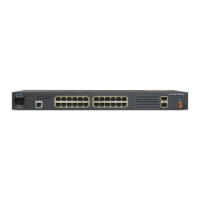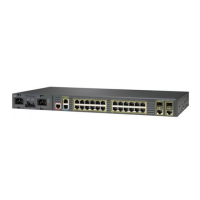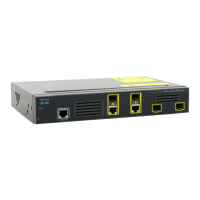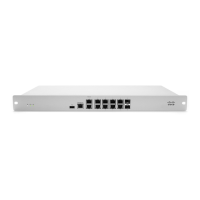36-18
Cisco ME 3400 Ethernet Access Switch Software Configuration Guide
OL-9639-07
Chapter 36 Configuring IPv6 Unicast Routing
Configuring IPv6
Beginning in privileged EXEC mode, follow these steps to configure an IPv6 static route:
Command Purpose
Step 1
configure terminal Enter global configuration mode.
Step 2
ipv6 route ipv6-prefix/prefix length
{ipv6-address | interface-id
[ipv6-address]} [administrative
distance]
Configure a static IPv6 route.
• ipv6-prefix—The IPv6 network that is the destination of the static
route. It can also be a hostname when static host routes are configured.
• /prefix length—The length of the IPv6 prefix. A decimal value that
shows how many of the high-order contiguous bits comprise the prefix
(the network portion of the address). A slash mark must precede the
decimal value.
• ipv6-address—The IPv6 address of the next hop that can be used to
reach the specified network. The next hop does not need to be directly
connected; recursion finds the IPv6 address of the directly connected
next hop. The address must be specified in hexadecimal using 16-bit
values between colons.
• interface-id—Specify direct static routes from point-to-point and
broadcast interfaces. On point-to-point interfaces, you do not need to
specify the IPv6 address of the next hop. On broadcast interfaces, you
should always specify the IPv6 address of the next hop, or ensure that
the specified prefix is assigned to the link, specifying a link-local
address as the next hop. You can optionally specify the IPv6 address
of the next hop to which packets are sent.
Note You must specify an interface-id when using a link-local address as
the next hop. The link-local next hop must be an adjacent router.
• administrative distance—(Optional) An administrative distance. The
range is 1 to 254; the default value is 1, which gives static routes
precedence over all but connected routes. To configure a floating static
route, use an administrative distance greater than that of the dynamic
routing protocol.
Step 3
end Return to privileged EXEC mode.
Step 4
show ipv6 static [ipv6-address |
ipv6-prefix/prefix length] [interface
interface-id] [recursive] [detail]
or
show ipv6 route static [updated]
Verify your entries by displaying the IPv6 routing table.
• interface interface-id—(Optional) Display only those static routes
with the specified interface as an egress interface.
• recursive—(Optional) Display only recursive static routes. The
recursive keyword is mutually exclusive with the interface keyword,
but it can be used with or without the IPv6 prefix in the command
syntax.
• detail—(Optional) Display this additional information:
–
For valid recursive routes, the output path set, and maximum
resolution depth.
–
For invalid routes, the reason why the route is not valid.
Step 5
copy running-config startup-config (Optional) Save your entries in the configuration file.

